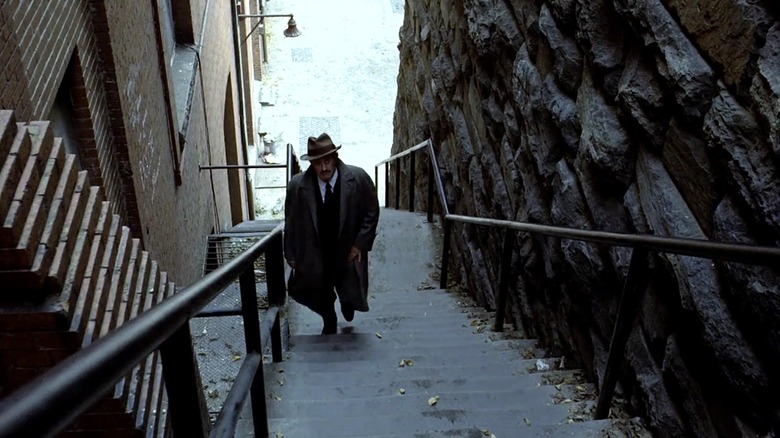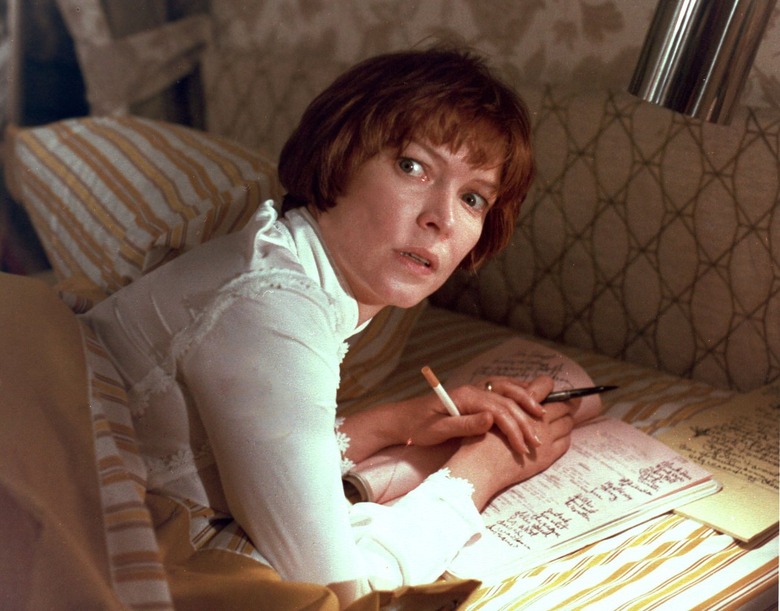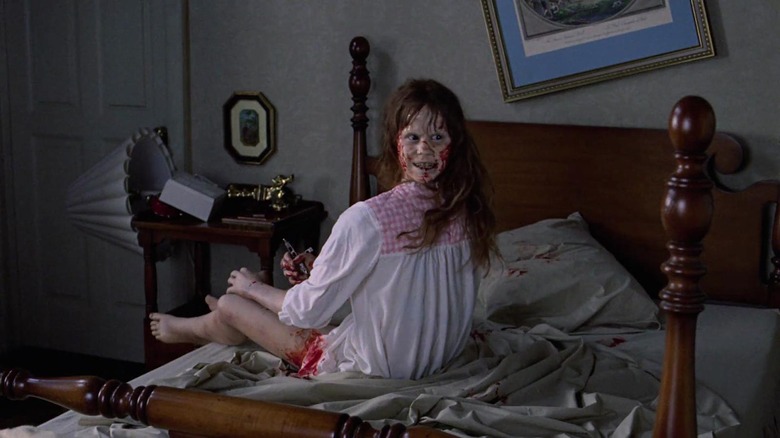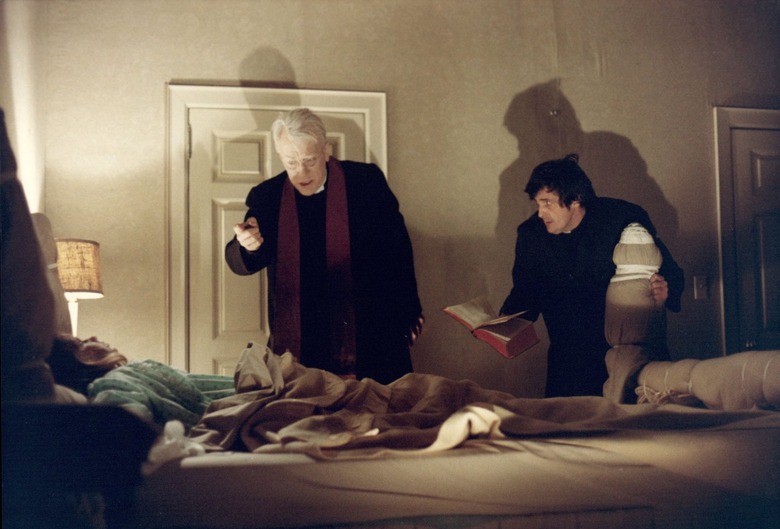A Horror Newbie Watches 'The Exorcist' For The First Time
(Welcome to The Final Girl, a regular feature from someone who has steered clear of horror and is ready to finally embrace the genre that goes bump in the night. Next on the list: William Friedkin's seminal Oscar-nominated horror film The Exorcist.)
I've passed by the Exorcist staircase more than a dozen times. And every time, someone in my group excitedly whispers "That's the stairs from The Exorcist," and we stare up silently, daunted by its steep incline and the worn-out stones. It's only a key location from one of the most acclaimed horror films in cinematic history, you know.
You see, in D.C., we don't have many landmarks that a movie buff can boast about, despite the plethora of films set in the nation's capital. Sure, movies feature countless helicopter shots of the Capitol and countless more highlighting the Washington Monument, but for the most part, those movies were all filmed in Baltimore. Better tax breaks, you know.
Amazingly, The Exorcist actually looks and feels like it was shot in Georgetown. There, the Georgetown University campus steps where I once got lost. There, the church where I'm pretty sure my cousin got baptized. The Georgetown Canal!
And of course, the infamous staircase. That staircase was the chief thing I knew about The Exorcist before going into the movie. That, and Linda Blair vomiting green slime while rotating her head. In any case, The Exorcist is part of that exclusive club of films that have become so iconic that they've bled through every corner of pop culture. Even non-horror fans know about it.
How Do You Watch a Movie You Know So Much About?
At this point, it's virtually impossible to avoid spoilers for a movie that are more than 10 years old. Honestly, it's almost impossible to avoid spoilers for a movie that's two weeks old. And this existed long before the internet. Bruce Willis was dead the whole time. Rosebud is the sled. Norman Bates is the killer. You end up knowing these things without quite remembering where you learned them, via inevitable pop culture osmosis.
So of course, I knew all the staples of The Exorcist before I even popped in the movie (or in this case, loaded it up on HBO Go). And I had a strange affinity for it too, by virtue of growing up close to Georgetown, where the movie was shot. But was I worried that this would color my impression of the movie? Not at all.
With horror films, pop culture has had a tendency to filter them down to their most shocking twists or iconic scenes. It's a reductive way of memorializing these movies, but stealthily, this has helped newcomers to the movies enjoy them without pretense.
I knew about those stairs, the foggy lamplight cab signaling the arrival of a priest, and the spinning head. So you can imagine how surprised I was when the film opened at a dusty archaeological dig in northern Iraq. It's a sweeping cinematic setting, one that could rival the scope of Lawrence of Arabia. But the dread seeps through even in this brightly-lit, sun-drenched scene, especially when Father Merrin (Max von Sydow) unearths a demonic amulet. The shot that follows is what convinced me that The Exorcist was operating on a higher level than the campy horror film I had expected to see: Merrin, stunned at his discovery of the ghastly amulet, stands atop a ruin gazing up at the larger statue of the demon, rabid dogs fighting in the background and an ominous buzzing noise growing louder. In the background, an orange, almost blood-red sun begins to set. Cinematographer Owen Roizman sets the tone for the rest of the movie — one of palatial, harrowing beauty.
I absolutely love von Sydow in this movie, and that the titular Exorcist doesn't show up again until an hour into the movie. Von Sydow was already a cinematic legend by the time The Exorcist was released in 1973, starring in existential classics like Ingmar Bergman's The Seventh Seal, which explored the borders between life and death. It's so fitting that he plays a character of such renown in the movie, whose reputation is built up to an almost deific nature. When he arrives in that foggy, lamplit scene, silhouetted against the light from Regan's window, the combined excitement of seeing that famous scene with von Sydow's presence made me giddy.
The Exorcist’s Feminist Agenda
The film quickly establishes Regan and her mother Chris (Ellen Burstyn) as a loving mother-daughter pair who struggle with Regan's absentee father and Chris' demanding acting career. And it feels uncommonly harmonious for the setting of a horror film.
In my limited experience with modern horror movies, they often feature troubled protagonists dealing with loss, grief, or failing relationships. But Regan and Chris are as loving as can be. Even the incident that triggers Regan's possession seems fairly harmless — the two of them cheerfully play with an Ouija board, which contacts Regan's "imaginary friend," which she calls Captain Howdy. There seems to be no outside factors that could single out Regan for possession. Or is there?
At the time of The Exorcist's release in the '70s, America and Hollywood were at the height of a colossal movement for women's rights. Divorce rates were on the rise, but so were women pursuing high-powered careers, equal pay, and greater reproductive rights. It was an era in which the American Dream of the nuclear family was slowly being replaced by single-parent or post-modern families. In this sense, Regan and Chris' loving relationship feels like a second-wave feminist dream: an independent, working mother and her compassionate child supported by hired help and female friends. But here is where I may say something controversial: The Exorcist is anti-feminist.
Or at least, The Exorcist was a response to the feminist ideals and unconventional family units that were sweeping the nation at the time period. Like any horror film, the "monster" is a surrogate for the social anxieties of the era. And in that era, one of the (many) social anxieties were powerful young women.
Though Regan and Chris seem harmonious, they're emblematic of much of the social unrest of the '70s. They're a "broken" family — Chris' profanity-laced breakdown when her ex-husband coldly brushes off his daughter, and Regan's insistence that Chris date her friend and director Burke Dennings (Jack Macgowran) are the first cracks under the peaceful surface. Worse, Chris is a career woman, whose newest film has uprooted her daughter to an old townhouse in Washington, D.C., and whose long hours take her away from Regan — with only the help available to raise her prepubescent daughter.
From Darling to Demon
Linda Blair's performance as Regan has been oft-parodied and frequently imitated, but it's still incredible. The sheer physical and mental dedication she lends to the role is astonishing. And of course, there's the strange catharsis of seeing a wholesome, dimple-faced girl transformed into profanity-spewing monster.
Regan is the root of the movie. There's not much to say about her at first — her sweet, empty personality barely registers before she is possessed. But that's the point.
An abundance of horror movies present children as the ultimate "monster." There's something grotesque about a character that is meant to be the height of innocence and purity, twisted into an unnaturally mature, sexualized entity. The trademark "creepy kids." You see it in classic films like The Omen, and modern horror films like Let the Right One In or Orphan. It's no surprise that they're often cherub-faced prepubescents: the "creepy child" is the vilification of sexual maturation and loss of innocence.
Regan is a precocious young girl, until it becomes a perversion. Before she is possessed, she quietly absorbs her mother's struggles — wise beyond her years about their situation. But as puberty approaches, she will do what any teenage girl will do: lash out. She curses, masturbates, attacks her mother. Possession becomes a stand-in for her coming-of-age, but instead of being presented as a natural occurrence, it is a gross curse.
Final Thoughts
There's so much in The Exorcist to chew on: the film's intriguing relationship with faith, the dysfunctional relationships with mothers, the conflict between psychology and religion. Scores of essays have already been written on those subjects — all that can articulate it better than a newcomer like me.
I was riveted by the performances, especially by Burstyn and Jason Miller, who plays the local priest struggling with his faith. The Exorcist is a sensational experience, anchored by Burstyn and Miller's incredibly human turns. I feel bad that it took me this long to mention Miller, but that's not to disparage his character, Father Damien Karras. He is the emotional core of this film, the embodiment of The Exorcist's conflict between science and faith. And Burstyn is incredible, never veering to far into the stereotypes of hysterical mother.
The Exorcist is probably my favorite of the movies I've watched for this series so far. It's a film that is equal parts character drama, existential angst, and bursts of shocking violence. And it was pretty darn cool seeing my hometown properly featured in a movie.




